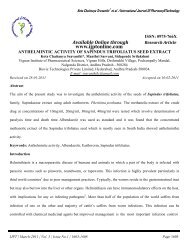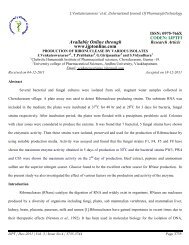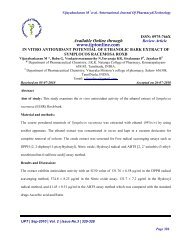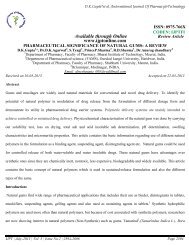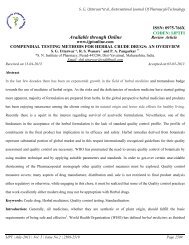Available Online through www.ijptonline.com
Available Online through www.ijptonline.com
Available Online through www.ijptonline.com
You also want an ePaper? Increase the reach of your titles
YUMPU automatically turns print PDFs into web optimized ePapers that Google loves.
R. Rajavel* et al. /International Journal Of Pharmacy&Technology<br />
vanadium <strong>com</strong>plexes have more effective whereas the nickel <strong>com</strong>plex exhibit mild antibacterial and antifungal<br />
activities against these organisms.<br />
2. Materials and methods<br />
All the chemicals used were purchased from Aldrich. Solvents used were of analytical grade and purchased<br />
<strong>com</strong>mercially and used such as. The purity of metal <strong>com</strong>plexes were tested by TLC.<br />
2.1. Methods<br />
Elemental analysis(C, H N) was obtained using Perkin Elmer elemental analyzer. The infrared spectra were<br />
recorded in Perkin-Elmer-283 spectrophotometer in the range of 4000-200 cm −1 and electronic spectra in DMF were<br />
obtained using Shimadzu UV-265 spectrometer. Conductivity measurements were carried out at room temperature on<br />
freshly prepared 10 −3 M DMF solutions using a coronation digital conductivity meter. The magnetic studies were<br />
carried out at room temperature on a Gouy balance calibrated with Hg[Co(SCN) 4 ]. The cyclic voltammetry studies<br />
were carried out in digital CHI 760C. The electrochemical behavior of the <strong>com</strong>plexes was examined by employing a<br />
platinum electrode as working electrode, Ag/AgCl as a reference electrode and platinum wire as auxiliary electrode.<br />
The working media consisted of DMF containing 0.1M tetra butyl ammonium perchloride(TBAP) as supporting<br />
electrolyte. The EPR spectra of Cu(II) <strong>com</strong>plex were recorded on Bruker EMX Plus at room temperature. The<br />
antibacterial activity of the <strong>com</strong>pounds were determined by using the disc diffusion method.<br />
2.2. Antimicrobial activity<br />
The standardized disk-diffusion method[12, 13] was followed to determine the activity of the synthesized<br />
<strong>com</strong>pounds against the sensitive organisms Gram-positive(staphylococcus auerus) and Gram-negative bacteria<br />
(pseudomonas fluorescens) and fungi ( Aspergillus fumigatus) Streptomycin was used as a standard reference in the case<br />
of bacteria while Fluconazole was used as a standard antifungal refrence.<br />
The tested <strong>com</strong>pounds were dissolved in[DMSO which has no inhibition activity] to get concentration of 2<br />
mg/mL. The test was performed on medium potato dextrose agar(PDA) which contains infusion of 200 g potatoes, 6<br />
g dextrose and 15 g agar[14]. Uniform size filter paper disks(three disks per <strong>com</strong>pound) were impregnated by equal<br />
IJPT | April-2012 | Vol. 4 | Issue No.1 | 4018-4031 Page 4020



